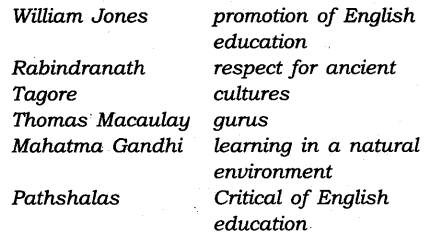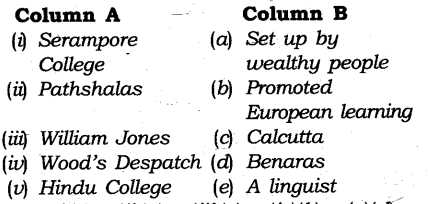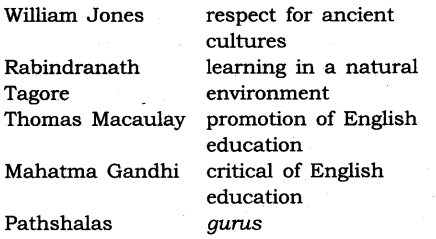Question 1.
Match the following:
Question 2.
State whether true or false
- James Mill was a severe critic of the Orientalists.
- The 1854 Despatch on education was in favour of English being introduced as a medium of higher education in India.
- Mahatma Gandhi thought that the promotion of literacy was the most important aim of education.
- Rabindranath Tagore felt that children ought to be subjected to strict discipline.
- True
- True
- False
- False
Question 3.
Why did William Jones feel the need to study Indian history, philosophy and law?
- William Jones came to represent a particular attitude towards India. He shared a deep respect for ancient cultures, both of India and of the West.
- Jones and Colebrooke felt that India had attained its glory in the ancient past. It declined later on. In order to understand India, it was necessary to discover the sacred and legal texts produced in the past.
- These texts would reveal the ideas and laws of Hindus and Muslims and would form the basis of future development.
- Jones and Colebrooke believed that their project would help the British learn from Indian culture. Indians would also rediscover their own heritage. In this way the British would become guardians and masters of Indian culture.
Question 4.
Why did James Mill and Thomas Macaulay think that European education was essential in India?
- James Mill was the one of those who attacked the Orientalists.
- He declared that the British should not teach what the natives wanted, or what they respected, in order to please them and “win a place in their heart”.
- The aim of education should be to teach what was useful and practical.
- Indians should be made familiar with the scientific and technical advances that the West had made, and not the sacred literature of the Orient.
- Macaulay urged the British government in India to stop wasting public money in promoting Oriental learning, for it had no practical use.
- He felt that knowledge of English would allow Indians to read some of the finest literature the world had produced; it would make them aware of the developments in Western science and philosophy.
- The teaching of English could thus be a way of civilizing people, changing their tastes, values, and culture.
Question 5.
Why did Mahatma Gandhi want to teach children handicrafts?
Mahatma Gandhi wanted to teach children handicrafts because of the following reasons:
- People would work with their hands and know how different things operated.
- The craft would develop their minds.
- It would also develop their capacities to understand.
Question 6.
Why did Mahatma Gandhi think that English education had enslaved Indians?
- According to Mahatma Gandhi, colonial education created a sense of inferiority in the minds of Indians. He said it made them see Western civilisation as superior which destroyed the pride they had in their own culture.
He said: It was sinful—it enslaved Indians—it cast an evil spell on them. - Charmed by the West, appreciating everything that came from the West, Indians educated in these institutions admired British rule.
- Mahatma Gandhi wanted an education that could help Indians recover their sense of dignity and self-respect.
- Mahatma Gandhi -strongly was in favour of Indian languages to be the medium of teaching.
- Education in English crippled Indians and distanced them from their own social surroundings. This made them “strangers in their own lands”. Speaking a foreign tongue (language), Indians started to hate local culture.
- Mahatma Gandhi further said that western education focused on reading and writing rather than oral knowledge;
- It valued textbooks rather than life experience and practical knowledge.
- He said education should develop a person’s mind and soul.
- Literacy or simply learning to read and write—by itself did not count as education.
- People had to work with their hands and learn a craft. They should know how different things operated.
Question 7.
Find out from your grandparents about what they studied in school.
- Urdu/Hindi language/Mathematics/Home science
Question 8.
Find out about the history of your school or any other school in the area you live.
I studied at St. John’s Acadamy. It is the oldest one in this region. It was established by a Christian Missionary in 1980. It has created many histories by achieving so many events to its credit. The Principal is always appointed by the missionary. The man of high academic repute and administrative quality is appointed here as Principal. Teachers are also of high talent. There are seven thousand students. Its students always bring high laurels to school and region by achieving brilliant results in Board Examinations. I am proud of my school.
Question 9.
Choose the correct option.
(i) The ideas of William Jones were supported by
(a) James Mill
(b) Thomas Macaulay
(c) Charles Wood
(d) Henry Thomas Colebrooke
(ii) A madrasa was set up in Calcutta in 1781 to promote the study of
(a) Urdu
(b) Arabic
(c) Ancient history of India
(d) Muslim religion
(iii) Who attacked the Orientalists?
( a) James Mill
(b) Thomas Macaulay
(c) Both (a) to (b)
(d) None of the above
(iv) The name associated with the establishment of Serampore Mission
(a) Thomas Macaulay
(b) Henry Thomas Colebrooke
(c) William Carey
(d) William Jones
(v) William Adam toured the districts of
(a) Bihar and Orissa
(b) Bihar and Bengal
(c) Bengal and Rajasthan
(d) Orissa and Madhya Pradesh
(i) (d), (ii) (b), (iii) (c), (iv) (c), (v) (b).
Question 10.
Fill in the blanks with appropriate words to complete each sentence.
- Warren Hastings took the initiative to set up the Calcutta ………… and believed that ancient customs of the country and ……………..of learning ought to be the basis of ………… rule in India.
- Thomas Macaulay saw India as an …………… country that needed to be.
- Together with Henry Thomas Colebrooke and Nathaniel Halhed, Jones set up the ……………. of Bengal, and started a journal called …………………
- Many British officials said that knowledge of the was full of errors and thought …………….
- There was no system of annual examinations in …………..
- Rabindranath Tagore started …………… in 1901.
- Madrasa, customs, oriental
- uncivilised, civilised
- Asiatic Society, Asiaticle Researches
- East, unscientific
- Pathshalas
- Shantiniketan
Question 11.
State whether each of the following statements is True or False.
- Wood’s Despatch emphasised the practical benefits of a system of European learning.
- Mahatma Gandhi never approved English education in India.
- Rabindranath Tagore did a lot for the spread of English education in India.
- Pathshalas followed strict rules and regulations.
- Thomas Macaulay was in favour of the promotion of Oriental institutions.
- James Mills was a Scottish missionary who toured the districts of Bengal and Bihar.
- Tagore set up his school, Le. Shantirdketan in a rural setting.
- True
- True
- False
- False
- False
- False
- True.
Question 12.
Match the hems given in Column A correctly with those given in Column B.
(i) (c), (ii) (a), (iii) (e), (iv) (b), (v) (d).
Question 13.
Name the different languages that William Jones studied.
Greek, Latin, English, French, Arabic and Persian.
Question 14.
Why was Calcutta Madrasa set up?
Calcutta Madrasa was set up to promote the study of Arabic, Persian and Islamic law.
Question 15.
Why was the Hindu College established in Benaras?
The Hindu College was established in Benaras to encourage the study of ancient Sanskrit texts that would be useful for the. administration of the country.
Question 16.
Name two individuals who sharply attacked the Orientalists.
James Mill and Thomas Babington Macaulay.
Question 17.
What did Thomas Macaulay urge the British government in India?
Thomas Macaulay urged the British government in India to stop wasting public money in promoting Oriental learning for it was of no practical use.
Question 18.
How were Oriental institutions like the Calcutta Madrasa and Benaras Sanskrit College viewed by the British?
These Oriental institutions were viewed as temples of darkness that were falling of themselves into decay.
Question 19.
Name the places where the British established universities.
Calcutta, Madras and Bombay.
Question 20.
Where were classes held under the system of pathshalas?
Classes were held under a banyan tree or in the comer of a village shop or temple or at the guru’s home.
Question 21.
What type of education was given to the children in pathshalas?
Children were given oral education in pathshalas.
Question 22.
Why were classes not held during harvest time?
It was because rural children had to work in the fields during harvest time.
Question 23 .
What task was assigned to the pandit by the Company?
The Company assigned the pandit to visit the pathshalas and try to improve the standard of teaching.
Question 24 .
Name two Indians who reacted against Western education.
Mahatma Gandhi and Rabindranath Tagore.
Question 25 .
What do you mean by Tagore’s abode of peace?
Tagore’s Shantmiketan was established in a rural setting, 100 kilometres away from Calcutta. As it was far from the din and bustle of the city it was an abode of peace.
Question 26.
How did Tagore view his school namely Shantmiketan?
He viewed his school as an abode of peace where living in harmony with nature, children would cultivate their natural creativity.
Question 27.
Why did many Company officials in India want to promote Indian rather than Western learning?
Many Company officials felt that institutions should be set up to encourage the study of ancient Indian texts and teach Sanskrit and Persian literature and poetry. These officials were of the opinion that Hindus and Muslims ought to be taught what they were already familiar with and what they valued and preserved, not subjects that were alien to them. They believed that only by doing this the British could win the hearts of the Indians, only then they could expect to be respected by their subjects.
Question 28.
What were the views of other Company officials?
Other Company officials did not approve the ideas of the Orientalists. They began to criticise the Orientalist- vision of learning. They saved that the knowledge of the East was full of errors and unscientific thought. They saw Eastern literature as non-serious and light-hearted. So, they argued that it was wrong on the part of the British to spend so much effort in encouraging the study of Arabic and Sanskrit language and literature.
Question 29.
Define the term ‘vernacular’. Why did the British use this term in colonial countries like India?
The term Vernacular’ refers to a local language or dialect as distinct from what is known as the standard language.
In colonial countries like India, the British used this term to mark the difference between the local languages of everyday use and English, the language of the imperial masters.
Question 30.
What measures were taken by the English Education Act of 1835?
The following measures were taken under the English Education Act 1835:
- English was made the medium of instruction for higher education.
- Promotion of Oriental institutiohs like the Calcutta Madrasa and Benaras Sanskrit College was stopped. These institutions were seen as temples of darkness that were falling of themselves into decay.
- English textbooks began to be produced for schools.
Question 31.
What measures were taken by the British after issuing of Wood’s Despatch?
Following measures were taken:
- Education departments of the government were set up to extend control over all matters regarding education.
- A system of universities education was introduced. Universities were established in Calcutta, Madras and Bombay.
- Attempts were also made to bring about changes within the system of school education.
Question 32.
How were the views of Tagore and Mahatma Gandhi on the West different?
Both Tagore and Mahatma Gandhi thought about education in similar ways. But there were differences too. Gandhiji was highly critical of Western civilisation and its worship of machines and technology. Tagore wanted to combine elements of modem Western civilisation with what he saw as the best within Indian tradition. He emphasised the need to teach science and technology at Shantiniketan, alongwith art, music and dance.
